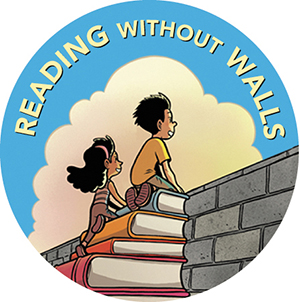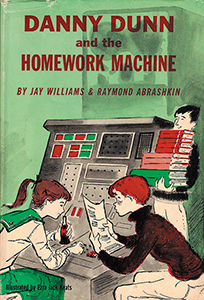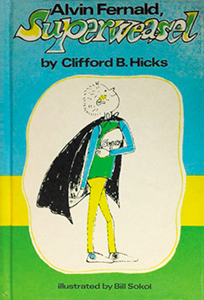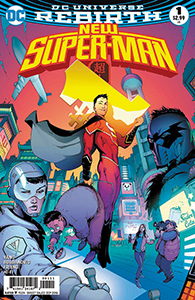Reading Without Walls: A Conversation with Gene Luen Yang
Gene Luen Yang, graphic novelist and the Library of Congress’s 2016–2017 National Ambassador for Young People’s Literature, has initiated a challenge to us all.
 Roger Sutton: I think Reading Without Walls is a wonderful program. What inspired you to do it?
Roger Sutton: I think Reading Without Walls is a wonderful program. What inspired you to do it?Gene Luen Yang: When I found out I was going to be named National Ambassador for Young People’s Literature, it was a shock. Mark Siegel, my editor, called me up, and for a little while I couldn’t even think about it, because it was such a big thing. I found out that every ambassador has a platform — Kate DiCamillo’s was Stories Connect Us. I met with folks from the Children’s Book Council and First Second Books, and we brainstormed and just hammered it out. I knew that I wanted to do something that was related to diversity, and I was particularly interested in the diverse interpretations of the word diversity, so we ended up landing on three different ways of thinking about it: diversity in terms of people, diversity in terms of topic, and diversity in terms of format. [visit readingwithoutwalls.com]
RS: One thing I really love about your platform is that it is bringing a wider sense of what that word means to the conversation.
GLY: If you look at our world, we’re becoming so much more diverse in every sense of the word. It’s not just about culture or identity. It’s also about the different ways we communicate. As somebody who’s kind of a technophile, I’m interested in how traditional and digital publishing connect. Maybe ten years ago they were seen as antagonists, but now they complement each other. There’s data that shows digital sales actually drive print sales. And even the ways in which pictures and words, text and image, interact — we’re seeing these books that are very hard to categorize. All of that is very exciting to me.
RS: Before every new issue of The Horn Book goes to press, one of the editors brings me a pile of books from the book review section. The books have been reviewed, the reviews have been edited, we love these books — but the editor will say to me, “Okay, where do you want to put them?” Because we have these three main categories: picture book, fiction, nonfiction. But books don’t so easily slot that way anymore.
GLY: No, they don’t. It’s really cool. It’s a really wonderful thing.
RS: Without going off on too much of a tangent — I’m afraid we’ll never come back — we’ve seen recently in illustration a lot of crossover from people who work in animation into books [see Betsy Bird’s article “Apples to Elephants: Artists in Animation” in the May/June 2015 issue of The Horn Book]. Do you see children’s books moving into realms other than print or printlike media? Do you think that children’s book people are going to be involved in types of digital storytelling?
GLY: I’m going to answer as a cartoonist, a comics guy. This is a debate that comic book people have, especially with the advent of webcomics in the late 1990s and early 2000s. At what point does a comic stop being a comic? If you use too many animated elements, if you use too many interactive elements, does it stop being a comic? Different people have arrived at different answers to that question. I’m pretty much a Scott McCloud devotee. He talks about how if you’re going to introduce animated elements into a comic, as long as those animated elements don’t affect time, he would still consider it a comic. In other words, if you have a panel where it’s raining, and the rain is falling — animated rain — that doesn’t affect the passage of time in the story. So he would still consider that a comic.
RS: What if it’s not raining in the next panel?
GLY: If it’s not raining in the next panel, it’s the panel that’s doing the work.
RS: I see.
GLY: Moving from one panel to the next is doing the time work. Whereas if you have a character who’s about to punch somebody, and they punch them, you’re moving through time in that way.
RS: Within the panel.
GLY: Yes. The punch itself moves time. So McCloud would no longer consider that a comic. That’s an animation. I think that’s a really strong way of thinking about it. At the very core of what a comic is, time and space are kind of the same thing. When your reader moves her eyes across the page, she should be moving through time in your story. So with the rain example, that still happens. She moves from the panel where it’s raining to the panel where it’s not. She moves across space and across time. But with the punching example, it’s no longer a comic, because her eyes stay in the same spot. They don’t move across space, but she’s moving across time. Some of that thinking may inform how we think of books as well. It may inform how we think of picture books especially, because there’s so much crossover between picture books and comics. Something else that I’m really excited about is how comics and picture books are each influencing how the other is made. Coming from the world of comics, I was very surprised that writers and illustrators, for the most part, don’t talk, and they don’t collaborate.
RS: In picture books.
GLY: Yeah, while the book is being drawn. It’s all done through the editor, right? That’s the traditional way of doing it.
RS: Right.
GLY: In comics, it is the exact opposite. In comics, if there’s a separation between the writer and the artist — if they’re not the same person — there’s an expectation that there’s going to be a lot of communication while the comic is being drawn. There’s a place for both methods of work, both types of processes. First Second, for example, is starting to put out picture books that are formatted as picture books but that are created in a comic book way, where there is interaction among the creators. So the end result is a picture book, but the way it’s made is like a comic. The writer and the artist collaborate throughout the entire process. I think that will bring about a different kind of story book, a different kind of picture book.
RS: Is there a point where you would stop calling a book a book, do you think?
GLY: Oof. Yeah, I guess so. Even in short texts, there is still that element of moving across time while moving across space. When you’re reading one sentence after the other, in most cases you are moving across time.
RS: In fiction you are. Poetry would be an example where you wouldn’t be, necessarily.
GLY: You’re right. Poetry would be different. I guess I would need to think about that question more. Those are the interesting, fuzzy places where publishing is going to go.
 National Ambassador for Young People's Literature Gene Luen Yang. Photo courtesy of the Library of Congress.
National Ambassador for Young People's Literature Gene Luen Yang. Photo courtesy of the Library of Congress.RS: Tell me about your own childhood reading. As a kid, I got into reading ruts. Most kids do. They like one kind of book, and they read as many of that kind of book as they can, and then when they’re done, they read them again. Did you read without walls as a child?
GLY: I was always a slow reader, from the very beginning. I remember in first grade our teacher divided us into groups, and I was definitely in the slow group. She didn’t call it that, but everybody in the class knew. But I still loved reading. Being a slow reader affected my grades in school, but it didn’t affect my love for reading. I still loved going to the library, and I still loved reading books. When I was little, I was really into Dr. Seuss. I guess every kid is.
RS: He scared me. Too creepy.
GLY: There is a creepiness to it, that’s true. I definitely agree.
RS: I was a nervous child.

 GLY: I think a lot of us who are in books now were nervous children. I’ve never been able to get through a Stephen King novel for that specific reason. I can’t stomach it. But I went through a Seussian phase, and then The Mouse and the Motorcycle, Beverly Cleary and all that. And then a phase where I was really into this guy named Clifford B. Hicks, who nobody reads anymore. He did a series of books that starred a kid named Alvin Fernald. Alvin Fernald, Superweasel. Alvin’s Secret Code. Alvin’s whole shtick was he’s a genius, and he figures out problems with his brain. Around the same time I was also really into Encyclopedia Brown, very similar kinds of books.
GLY: I think a lot of us who are in books now were nervous children. I’ve never been able to get through a Stephen King novel for that specific reason. I can’t stomach it. But I went through a Seussian phase, and then The Mouse and the Motorcycle, Beverly Cleary and all that. And then a phase where I was really into this guy named Clifford B. Hicks, who nobody reads anymore. He did a series of books that starred a kid named Alvin Fernald. Alvin Fernald, Superweasel. Alvin’s Secret Code. Alvin’s whole shtick was he’s a genius, and he figures out problems with his brain. Around the same time I was also really into Encyclopedia Brown, very similar kinds of books.RS: Did you read Danny Dunn?
GLY: No.
RS: Oh, man. You would have been the perfect Danny Dunn reader. You’re probably a little too young for his heyday. Danny Dunn was a young scientist-inventor who solved mysteries and made things, like Danny Dunn and the Homework Machine. Totally up your alley.
GLY: There’s a whole kid-genius subgenre. And then I remember being in fifth, sixth grade, going to the library, and our library back then did not have a very well-developed YA section. It went from J to Adult, and I remember feeling kind of lost at the library for the first time. That’s when I started reading comics pretty heavily. When I was a kid, all that was available were superhero comics and so that’s what I read for years.
RS: I read Superman — he’s DC, right? The Marvel comics I didn’t like. I was a DC boy.
GLY: I was a Marvel person for sure. The two superhero universes have very different feels, very different strengths. I think that, in general, if you’re more cynical, you gravitate toward old-school Marvel, and if you’re more hopeful, you gravitate toward DC.
RS: That was definitely my feeling as a kid, that the good guys in the DC comics were good, in an unalloyed way. They were always kind of shadowed in the Marvel universe.
GLY: Yeah, they were always flawed.
RS: So how did you react, as a kid, when someone tried to get you to read something outside your comfort zone?
GLY: Kid-me probably would have reacted poorly to adult-ambassador-me. At the same time, there were books I was required to read that were definitely outside my comfort zone that I ended up loving. One was To Kill a Mockingbird. That was required reading in seventh grade. You know the book that blew me away? In eighth grade we had to read Upton Sinclair’s The Jungle. It was one of the few books where I read the first chapter really fast, didn’t understand what was going on, and decided to go back and read slowly. I got very into that book. I loved that book.
RS: It’s got a lot of good gory stuff for kids.
GLY: That’s exactly it. I couldn’t stomach Stephen King, but I could stomach The Jungle. And Black Boy by Richard Wright. I read that when I was a sophomore in high school. That was also outside my comfort zone, but it was the only book that was assigned at school that I finished before the due date — well before the due date. I read it in two nights, and I ended up doing my senior paper on Richard Wright because I loved the book so much.
RS: You know, one ongoing fight I’ve had with a lot of young adult novelists who want more YA lit taught in school is I feel like school is the place to introduce kids to books that they’re not going to pick up on their own. It’s more likely that a kid is going to pick up a young adult novel than it is that he or she is going to pick up The Jungle or Black Boy, I think.
GLY: I can see that. My best teachers, the teachers who had the deepest effect on my reading, combined the two. They would mix required reading with reading where you had some choice, you had some autonomy. There’s a place for both. A good teacher will know how to find that balance.
RS: If the teacher demonstrates that she respects what the kid is reading on her own, then that kid is more likely to listen to a recommendation from a teacher.
GLY: You’re right.
RS: So how do we go about creating Reading Without Walls without kids feeling like they’re being told to do something?
GLY: Some of the thinking behind the design is toward autonomy. Even if this is presented as a school assignment — even if your teacher is challenging you to read without walls — you have complete control over how you fulfill that challenge. The kids can take ownership of it. Even with the three different choices between character, topic, and format, we want them to be able to choose what they want. We want them to feel they have control over how they do what they do.
RS: Where do you fit genre into that? To me, genre’s the hardest thing to jump. When I taught a reviewing class, I had my students read a book in a genre they claimed to detest and write a review of it. So if you said, “I hate romance novels,” you had to read a romance novel. “I hate Westerns”? You’ve got to read a Western. I asked people in the class who were fans of that genre to recommend titles — like, to the person who hated science fiction, I said, all right, who’s a big science fiction fan? What do you want this science fiction neophyte to read? What would be a great first science fiction book? I don’t know if we made any converts, but people definitely found new books that they loved.
GLY: That’s awesome. I think all of us, in a very casual way, end up reading without walls or watching without walls because of friends. Like I said, I’ve always had no stomach for horror. But I have this friend I used to teach with who was a huge zombie fan, and he got me onto World War Z, and he also let me borrow his copy of the movie Zombieland. Those two together — I don’t know if I’m a zombie fan now, but it made me at least appreciate why people like that kind of stuff. Zombies aren’t about zombies. It’s not about the dead bodies. I think it’s a very hopeful subgenre. It says that regardless of what happens, humanity will get through it. We’ll figure out a way to survive.
RS: I remember when vampires were so big, and publisher Jean Feiwel told me zombies were going to be the next big thing. I said, “Jean, you’re crazy. Vampires are sexy. Zombies are not.” I laughed at her. And she was completely right.
GLY: She was totally right. But had I been sitting in on that conversation, I would have agreed with you.
RS: I’ve still never read a zombie novel.
GLY: Oh, really? You should try World War Z.
RS: All right. There, I have my Reading Without Walls recommendation. Let’s work on yours. Have you read Stephen King’s book about the guy who goes back in time to stop Kennedy from being assassinated? That you might like. The title of it is the date of the assassination. 11/22/63.
GLY: Okay, maybe that’s my Reading Without Walls, then. Stephen King is one of those guys where I can tell that he’s talented. I can see why other people like him. I just feel like I’m too much of a weenie to get through it. I do love his On Writing, though.
RS: He’s one of those writers I look at and think I really wish I were into him, because he’s written so much. I’d be set for life. Don’t you love it when you discover a new writer you like and then realize that they’ve got twenty other books?
GLY: Yeah.
RS: Do you get into reading ruts?
 "Chinese Super-Man comic written by Yang.
"Chinese Super-Man comic written by Yang.GLY: Sure. Actually, I find that nowadays it’s just gotten harder for me to read for fun. It feels like all of my reading is research-based. Right now, I’m reading Eddie Huang’s Fresh Off the Boat, because I’m doing a comic based on the television series. A good chunk of my reading now is based on what I’m writing. I have to keep up with the Superman corner of the DC universe now that I’m writing in that corner.
RS: Come over to the light, Gene.
GLY: I’m trying. How about you? Do you find yourself in reading ruts?
RS: Oh, yeah. I’m on vacation now, and I’m trying to only read books for adults. But I look at my Kindle, which is how I read for fun, because my eyesight is not good at all. I probably have three hundred books on my Kindle. There’s history, biography. There’s serious fiction. There’s chick lit. There’s all kinds of stuff. But I’m scrolling through, and it’s like, oh, I might as well read another mystery. That can get to be a rut for me.
GLY: When you’re on vacation, you’re allowed to be in ruts, right?
RS: Yes. Well, I don’t think people should ever scold themselves for what they’re reading or what they’re not reading. What I like about Reading Without Walls, though, is that the whole approach to it is, well, approachable.
GLY: I hope so. That’s why we only chose to make the challenge one book. Just read one book, and you get to figure out which one you want. I hope it’s fun for the kids. A few librarians, bookstore owners, and teachers have sent me photos of how the challenge went. They’ve put so much creativity into how they executed the challenge, the kids couldn’t help but have fun.
From the March/April 2017 issue of The Horn Book Magazine.
RELATED
RECOMMENDED
ALREADY A SUBSCRIBER? LOG IN
We are currently offering this content for free. Sign up now to activate your personal profile, where you can save articles for future viewing.







Add Comment :-
Comment Policy:
Comment should not be empty !!!
Andulamb
A sad reality of the literary world is that great books lose popularity and fade away. My wife sent me a link to this article due to the mention of the Danny Dunn series, which I think has been unfairly forgotten. The series is a perfect fit for the Reading Without Walls challenge, as no one lives like Danny Dunn. Here's a link to my review of this great series: https://allisonsbookbag.wordpress.com/2012/11/17/dannydunn/Posted : Mar 08, 2017 10:04